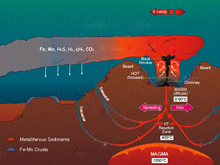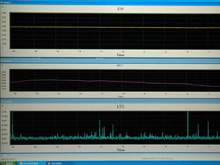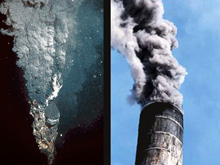
The hot waters emanating from hydrothermal vents are less dense then seawater and rise up above seafloor volcanoes into the ocean above, forming a plume. As the hot waters rise, they pull in surrounding water, becoming diluted and expanded. Within ten minutes or so the water has risen anywhere from 100 to 250 meters or more above the volcano and has pulled in almost 10,000 times its volume in surrounding seawater, spreading the hydrothermal waters into a large cloud or plume, left to drift with the current like smoke in the wind. Click image for larger view and image credit.
Hunting for Hydrothermal Vents
December 10, 2005
Joe Resing
Chemical Oceanographer
Exploring the Galapagos Spreading Center and searching for hydrothermal activity is not an easy task. We want to know about activity occurring thousands of meters deep underwater, in a murky realm lacking light. For us to “see” the topography of the region we are exploring, we have been using sound to create pictures and maps of the region. One instrument that makes these maps, called the DSL-120, is towed behind the ship at 100 meters above the seafloor. The maps are slightly less than one kilometer wide. While we make these maps, we are also hunting for hydrothermal vents by putting sensors on the DSL-120. The sensors don’t find the vents themselves, but detect their plumes which are emitted into the ocean waters above the volcanoes. By comparison to the sonar which looks at a kilometer wide swath of the seafloor, the hydrothermal plume sensors can sample only inches of the surrounding seawater.
Hydrothermal vents are hot springs in the ocean floor whose sources of heat are submarine volcanoes. The hot waters coming from the vents are less dense than seawater and rise up above the volcano into the water above as a plume. This is very similar to smoke coming from a smoke stack, or a volcanic plume coming from a volcano on land. The hot waters rise, expand, and drift in the current like smoke in the wind. As the water rises up, it pulls in surrounding sea water, which dilutes the hydrothermal water. Within ten minutes or so the hot water has risen anywhere from 100 to 250 meters or more above the volcano and has pulled in almost 10,000 times its volume in surrounding seawater, expanding the hydrothermal waters into a large cloud or plume. The 10,000 times dilution has almost eliminated any temperature difference between the plume and the surrounding deep ocean waters.

This monitor displays incoming data from sensors attached to the DSL120. An Eh sensor detects reduced chemical compounds that are oxygen poor, while a methane sensor (MET) measures the amount of methane in surrounding waters, and a light scattering sensor (LSS) detects particle densities in the water. Anomalies detected by each sensor may indicate the presence of hydrothermal plumes. Click image for larger view and image credit.
The hot water that comes out of these springs has been circulating through the volcanic rocks for months to years. The hot water reacts with and dissolves the volcanic rocks. When the hot, mineral-rich water exits the vent into the cold ocean waters, the dissolved minerals start to precipitate, forming a visible cloud of particles. These particles can be detected with an instrument call a light scattering sensor. the hydrothermal water lacks oxygen and has many chemical compounds that are oxygen poor, or as a chemist would say, are reduced. We can detect these compounds with another sensor called an Eh sensor. Finally, many hydrothermal vents are rich in methane, which we can detect with a methane sensor.
We have placed these three sensors on the towed sonar system (DSL-120) which flies approximately 100 meters above the seafloor. These instruments report to us as we tow the DSL120 and help us to identify areas of hydrothermal activity when we will return to conduct plume sampling and photographic imaging of vents on the seafloor.
To be successful, we must tow the sonar and plume sensors through a hydrothermal plume. If we go directly over a hot spring, we will see a plume. If we tow the instrument down-current from the spring, again we should see a plume. However, if the current takes the plume away from us, or the plume rises higher or lower than the sensors, then we won’t detect it. If there is a strong current, regardless of direction, the plume will bend over and may not reach the height of the sonar until it has “blown” off the volcanic ridge. We currently have no idea what the deep sea currents in our survey region are like, and are unable to account for this with our survey lines.

Hot waters emanating from hydrothermal vents are less dense than seawater and rise up above the volcano into the water above as a plume. Similar to smoke coming from a smoke stack, the hot waters rise, expand, and drift in the current like smoke in the wind. Much like smoke plumes dispersing into air, as the water rises up it pulls in surrounding seawater, diluting the hydrothermal water. Click image for larger view, detailed caption and image credit.
Another factor is the density of the deep ocean water. The water in the ocean gets more dense, or heavier, as you go deeper in the ocean. In areas where the density changes greatly over a depth interval, hydrothermal waters have a more difficult time rising. In many areas like the western-most area of the GSC, the deep waters may have the same density for 100s of meters. In these areas, the hydrothermal fluids can rise more easily through this layer. The result is that the hydrothermal “cloud” may reside several hundred meters above the ocean floor and well above the sonar system on which the plume sensors are mounted. In this case our ability to detect a hydrothermal source relies on passing almost directly above it.
During our surveys so far, we have been successful in detecting hydrothermal plumes with our sensors. But even with these signals, pinpointing the vents themselves will be difficult. The plumes detected may have drifted hundreds of meters from the actual vent source, carried away by the currents. Or perhaps we flew over a field of vents and did not even know it due to water density and plume height. Despite the many factors contributing to plume height, direction and flow, our readings have indicated active hydrothermal venting along our survey area. Now we just need to send the Medea camera sled - our eye in the sea - down to find and confirm the hydrothermal vent sources.
GalAPAGoS: Where Ridge Meets Hotspot will be sending daily reports from Dec 3 - Jan 10. Please check back frequently for additional logs from this expedition.
Sign up for the Ocean Explorer E-mail Update List.




























